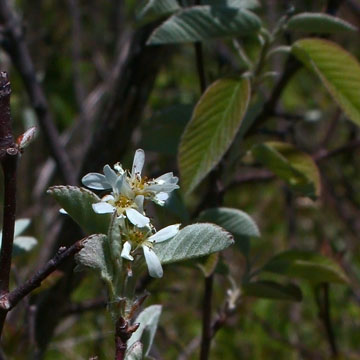

Amelanchier humilis - (image 1 of 5)
Taxonomy
Family: Rosaceae
Habitat
Dry, calcareous, open areas on rocky, gravelly or sandy soil.
Associates
Distribution
Quebec to Saskatchewan, south to MS, WV, OH, IN, IL, MO, and KS.
Morphology
Rhizomatous or suckering shrub; stems 1-50, up to 1.5 m or taller in shaded conditions; leaves elliptic or oblong to ovate or obovate, rounded to cordate at the base, the margins with mostly 1-6 teeth on each side on the proximal half and 3-6 teeth in the distal cm, the largest teeth over 1 mm, apex broadly subacute to rounded and mucronate, undersurface densely hairy at anthesis, becoming moderately hairy or rarely glabrous later; inflorescences erect, mostly with 7-11 flowers; ovary and fruit densely hairy at the summit; fruit almost black, 5-8 mm wide.
Notes
Flowers April to May
Wetland Indicator: NA
Has in the past been considered conspecific with A. spicata which has larger fruit (7-12 mm wide) and veins that do not extend into the marginal teeth. The primarily lateral veins of the leaves in A. spicata also tend to curve forwards (vs. nearly straight) and fork several times before reaching the margin (vs. forking once or a few times).
The name A. stolonifera, which is synonymous with A. spicata, has also sometimes been misapplied to A. humilis.
References
Campbell, C.S., Burgess, M.B., Cushman, K.R., Douchette, E.T., Dibble, A.C., and Frye, C.T. 2008. Amelanchier In: Flora of North America Editorial Committee (Eds.). Flora of North America North of Mexico. Vol. 9. Oxford University Press, New York, New York.
Gleason, Henry A.
and A. Cronquist. 1991. Manual of Vascular Plants of Northeastern United States
and Adjacent Canada. Second Ed.
The New York Botanical Garden. Bronx, NY
|
© Michael Hough 2018 |